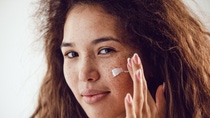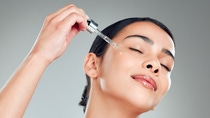Media
How much do you know about the ingredients of your skincare products?

BY MARIANA LICIO
American consumers are increasingly seeking more bio-based, natural products for their skin. But for anyone who doesn’t have a chemistry degree, understanding ingredients in labels and what they do can be challenging.
For this reason, we asked our BASF experts, Michael Lull, Head of Technical Service, and Kate Drummond, Head of Marketing in the Personal Care Ingredients division in North America, to explain some of the typical ingredients you can find in skincare products and what they do.
Typical ingredients in skincare products
According to Lull, some of the most common ingredients in skincare products are polymers, emulsifiers, and emollients, also known as chassis materials, as well as active materials like retinol or other vitamins, botanical extracts, peptides, and ferments.
Polymers are used in thousands of different products. There are natural polymers in our bodies, such as collagen, and others that have been developed to improve the performance of products.
Polymers can, for example, make products water- or sweat-resistant or make water-based products like shampoos and lotions feel thicker, creamier, and smoother.
When it comes to emulsifiers and emollients, the first one essentially helps bind ingredients that would normally separate, like water and oil, and can even promote better absorption of products in the skin, while emollients are used to prevent water loss and create a softening effect on the skin. Some examples of emulsifiers are steareth-2, glyceryl stearate, and sodium stearoyl glutamate, while popular emollients include shea butter, esters, hydrocarbons, natural oils, and mineral oils.
Active materials, on the other hand, are used to address specific skin issues, such as dry or oily skin, the appearance of wrinkles and fine lines, and the onset of acne or eczema. These actives can include antioxidants like Vitamins C and E, hyaluronic acid, retinol, botanical extracts, and ferments.
According to Lull, “to understand this better, you can think of it like the ingredients of a cake. The chassis ingredients are the flour, sugar, and butter that make up the body of the cake and determine its texture and appearance. The actives are the icing and other decorative elements that you add to the cake to make it more unique, focused, or special. Like when creating a birthday cake with someone’s favorite colors.”
A healthy skin microbiome is associated with a strong barrier function, and today’s consumer is more interested in achieving healthy skin, as opposed to just warding off aging as was demanded in the past...
How to choose natural ingredients for your skincare products
Skincare products have come a long way. Today, consumers want products that are safe, live up to their claims, and can address several skin issues at once.
“Many consumers associate naturality and natural ingredients with safety, as they appreciate seeing familiar materials on the ingredients list of their favorite products. This consumer sentiment continues to drive demand for our naturally derived products,” explains Drummond.
As a result of this demand, the personal care industry has moved towards nature-based ingredients, many of which support the skin’s natural microbiome.
Some of the most popular ingredients today due to their nurturing properties are:
To make sure the products you use include natural ingredients, look for certifications like USDA Organic, COSMOS, or NATRUE (International Natural and Organic Cosmetics Association), which ensure that ingredients are produced organically and sourced responsibly. BASF products are often certified by one or more of these organizations.
Additionally, BASF uses the ISO 16128 standard, a guideline that defines natural and organic ingredients and helps establish the percentages of the natural origins of a product.
Sustainable sourcing of ingredients is an important consideration when selecting a personal care product. Manufacturers can provide information that demonstrates that the products you use were produced in a socially responsible and environmentally friendly way. For example, BASF’s Argan Program, established in 2005, involves the cooperative farming of argan oil. Today, more than 1,000 women from rural areas in Morocco are working in the cooperatives.
Your type of skin is key to selecting products, so make sure to contact your dermatologist to find out more about the best ingredients for your specific skin.
BASF’s newest bio-based skincare ingredients
BASF has long been working on products that are naturally derived, which include natural-sourced botanicals, upcycled raw materials, and ferments, all of them backed by clinical efficacy data.
During the 2023 New York Society of Cosmetic Chemists (NYSCC) Supplier’s Day, BASF launched several new products in line with the wants and needs of consumers, including our VerdessenceTM portfolio of biopolymers, and ProbioliftTM and PostbioliftTM, the first of their kind, fermentation-derived bioactives in the market.
Biopolymers are polymer materials created by or from natural sources. Lull describes their role in skin care formulations, “They give you your initial impression of the product, how it sits in the jar or dispenses, and the way it first feels when applied or rubbed into your skin.”
The VerdessenceTM portfolio includes biopolymers that are naturally sourced, biodegradable and multifunctional.
An overlooked bacteria stars in BASF’s one-of-a-kind products
BASF discovered a bacteria known as Lactobacillus crispatus, which is highly present in the skin of young people yet is practically non-existent in the skin of older individuals. After isolating this bacteria, BASF scientists developed two ingredients: ProbioliftTM, which includes the “living cells of L. cispatus which ‘wakes up’ in contact with water on the skin,” explains Lull, and PostbioliftTM , which is a ferment extract. Both of these products “work independently or together in cosmetic formulations to help support healthier-looking skin and graceful aging.”
These probiotic and postbiotic products offer a wide variety of benefits for the skin. They can help:
- reduce the appearance of fine lines and wrinkles,
- enhance the density of skin, and
- support the antioxidant protection of the skin.
Learn more about BASF’s newest products and sustainability initiatives on the North America Personal Care website.
Published on September 5, 2023, by Mariana Licio.
For media inquiries or to repurpose this article, please contact Lisa Brown.
